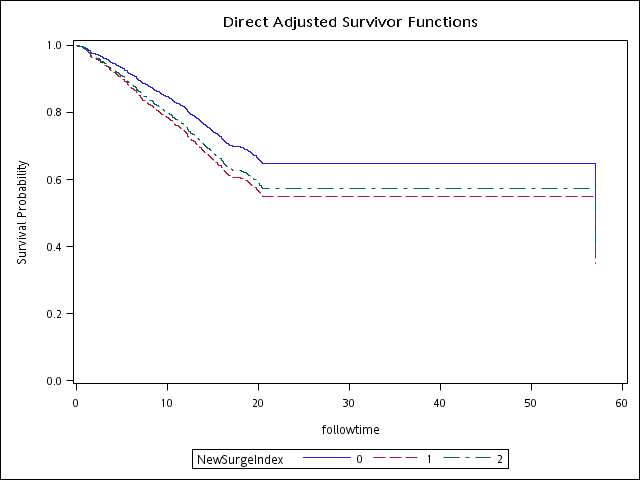- Home
- /
- Analytics
- /
- Stat Procs
- /
- Re: How to overlay 2 survival plots with adjustment of confounders
- RSS Feed
- Mark Topic as New
- Mark Topic as Read
- Float this Topic for Current User
- Bookmark
- Subscribe
- Mute
- Printer Friendly Page
- Mark as New
- Bookmark
- Subscribe
- Mute
- RSS Feed
- Permalink
- Report Inappropriate Content
Sanjay,
Thank you for trying to help!
The SAS I'm using is in version 9.4.
Regarding to the data, it's a traditional survival data which contains
#1 event variable: allcause, 0 as not dead, 1 as dead
#2 follow-up time: followtime
#3 main independent variable: NewSurgeIndex: 1, 2, and 3 represent 3 different groups
#4 other confounders: sex age bmi_1 smoke alcohol ldl_c meansbp nightdaysbpratio
Again, what I'm trying to do is to estimate survival probability for NewSurgeIndex with adjusting for confounders.
Moreover, in order to make these three groups comparable, so I need to draw these three survival curves on the same graph.
Actually, I've came out one way to achieve this:
ODS GRAPHICS ON;
PROC PHREG DATA=one PLOTS(OVERLAY)=SURVIVAL;
CLASS NewSurgeIndex;
MODEL followtime*allcause(0)= sex age bmi_1 smoke alcohol ldl_c
meansbp nightdaysbpratio NewSurgeIndex;
BASELINE COVARIATES=one OUT=Pred1 SURVIVAL=_ALL_/ DIRADJ GROUP=NewSurgeIndex;
ODS GRAPHICS OFF;
However, very welcome if you have any better idea!
Accepted Solutions
- Mark as New
- Bookmark
- Subscribe
- Mute
- RSS Feed
- Permalink
- Report Inappropriate Content
Using a categorical variable in the CLASS statement is the usual way to compare groups. As you've seen, this also overlays the various groups on the ODS graphics that the procedure creates.
- Mark as New
- Bookmark
- Subscribe
- Mute
- RSS Feed
- Permalink
- Report Inappropriate Content
Using a categorical variable in the CLASS statement is the usual way to compare groups. As you've seen, this also overlays the various groups on the ODS graphics that the procedure creates.
- Mark as New
- Bookmark
- Subscribe
- Mute
- RSS Feed
- Permalink
- Report Inappropriate Content
Now I can use it more confidently.

The 2025 SAS Hackathon has begun!
It's finally time to hack! Remember to visit the SAS Hacker's Hub regularly for news and updates.
ANOVA, or Analysis Of Variance, is used to compare the averages or means of two or more populations to better understand how they differ. Watch this tutorial for more.
Find more tutorials on the SAS Users YouTube channel.



